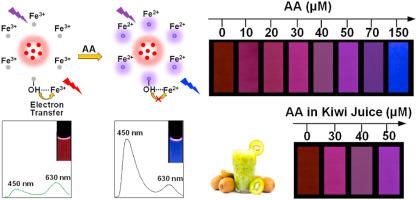Dyes and Pigments ( IF 4.1 ) Pub Date : 2020-11-07 , DOI: 10.1016/j.dyepig.2020.108995 Tingting Zhao , Chen Zhu , Shuai Xu , Xinghan Wu , Xiaotong Zhang , Yurong Zheng , Mengjiao Wu , Zhiwei Tong , Weijun Fang , Kui Zhang

|
Monitoring the concentration of ascorbic acid (AA) in biological samples is essential to food quality and healthcare. Various fluorescence methods widely reported for the detection of AA are usually based on “turn-on” or “turn-off” principle. However, few ratiometric fluorescent sensors were reported for AA determination. Additionally, the application of ratiometric fluorescence probe is usually limited by the narrow range of color changes and insensitivity color change of the AA concentration. Herein, a novel ratiometric fluorescent test paper to achieve the continuous color changes from red to blue was developed for the fluorometric qualitative and quantitative determination of AA. The nanoprobe consists of blue-emitting carbon dots (C-dots) and red-emitting silica coated quantum dots (QDs@SiO2) with certain ratiometric fluorescence intensity of blue to red. The fluorescence of blue-emitting CDs (peaking at 450 nm) is quenched by Fe3+, then the blue fluorescence is restored consecutively with the gradual increasing of AA concentration due to the reduction from Fe3+ to Fe2+ by using AA. While the fluorescence of red-emitting QD@SiO2 (peaking at 630 nm) works as a stable internal standard. Therefore, a distinguish color transition from red to blue can be observed by naked eyes intuitively with the increasing of AA concentration. By calculating the ratiometric fluorescent intensity at 450 nm and 630 nm or observing the color of the mixture solution by naked eyes, the concentration of AA can be detected easily and accurately. Under optimized conditions, the fluorescent intensity ratio (I450/I630) shows linear relationship with the concentration of AA from 0 to 70 μM with the detection limit as low as 3.17 μM. Finally, a ratiometric fluorescent sensor paper was further developed for AA detection with satisfactory results in fruit juice. The method proposed here gives the wide applications of fluorescent test paper in food and biological assays.
中文翻译:

使用混合碳点-二氧化硅包覆的量子点的比例荧光纸对抗坏血酸进行荧光颜色分析
监测生物样品中抗坏血酸(AA)的浓度对于食品质量和医疗保健至关重要。广泛报道用于检测AA的各种荧光方法通常基于“开启”或“关闭”原理。但是,很少有比例荧光传感器用于AA测定。另外,比例荧光探针的应用通常受到AA浓度变色范围窄和不敏感变色的限制。本文中,开发了一种用于实现从红色到蓝色的连续颜色变化的新型比例荧光试纸,用于荧光定量定性和定量测定AA。纳米探针由发射蓝光的碳点(C-dots)和发射红光的二氧化硅涂覆的量子点(QDs @ SiO 2),并具有一定比例的蓝色到红色荧光强度。Fe 3+猝灭发蓝光的CD(在450 nm处)的荧光,然后由于使用AA从Fe 3+还原为Fe 2+,随着AA浓度的逐渐增加,蓝色荧光连续恢复。而发红光的QD @ SiO 2的荧光(峰值波长为630 nm)可作为稳定的内标。因此,随着AA浓度的增加,可以用肉眼直观地观察到从红色到蓝色的明显颜色过渡。通过计算在450 nm和630 nm处的比例荧光强度或用肉眼观察混合物溶液的颜色,可以轻松,准确地检测AA的浓度。在最佳条件下,荧光强度比(I 450 / I 630)显示了从0到70μM的AA浓度的线性关系,检出限低至3.17μM。最后,进一步开发了一种比例荧光传感器纸,用于果汁中的AA检测,结果令人满意。本文提出的方法使荧光试纸在食品和生物测定中具有广泛的应用。











































 京公网安备 11010802027423号
京公网安备 11010802027423号